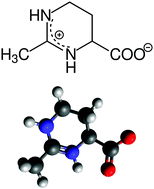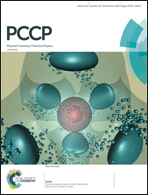Influence of compatible solute ectoine on distinct DNA structures: thermodynamic insights into molecular binding mechanisms and destabilization effects†
Abstract
In nature, the cellular environment of DNA includes not only water and ions, but also other components and co-solutes, which can exert both stabilizing and destabilizing effects on particular oligonucleotide conformations. Among them, ectoine, known as an important osmoprotectant organic co-solute in a broad range of pharmaceutical products, turns out to be of particular relevance. In this article, we study the influence of ectoine on a short single-stranded DNA fragment and on double-stranded helical B-DNA in aqueous solution by means of atomistic molecular dynamics (MD) simulations in combination with molecular theories of solution. Our results demonstrate a conformation-dependent binding behavior of ectoine, which favors the unfolded state of DNA by a combination of electrostatic and dispersion interactions. In conjunction with the Kirkwood–Buff theory, we introduce a simple framework to compute the influence of ectoine on the DNA melting temperature. Our findings reveal a significant linear decrease of the melting temperature with increasing ectoine concentration, which is found to be in qualitative agreement with results from denaturation experiments. The outcomes of our computer simulations provide a detailed mechanistic rationale for the surprising destabilizing influence of ectoine on distinct DNA structures.



 Please wait while we load your content...
Please wait while we load your content...